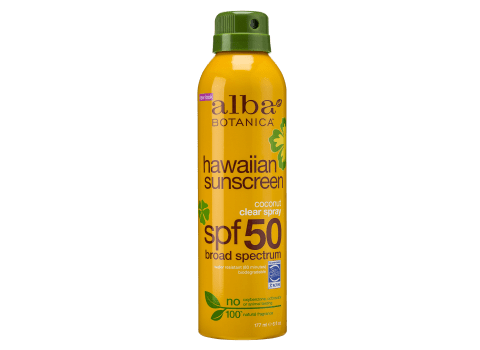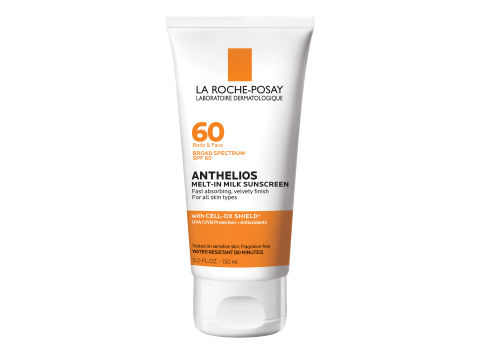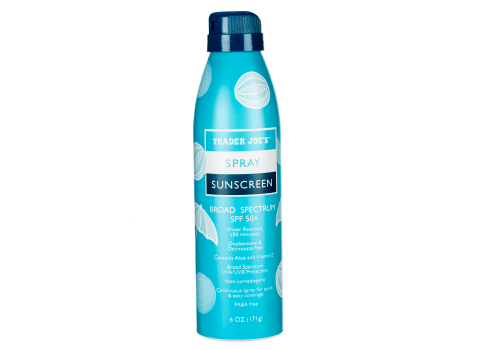Your Sunscreen Safety Questions, Answered
What you need to know about oxybenzone, sprays, benzene, and more

By Sally Wadyka
There has been a lot of news recently raising alarms about sunscreens. Last summer, several spray sunscreens were recalled after benzene, a known carcinogen, was detected in them. Other research has shown that some sunscreen ingredients can seep through skin into your bloodstream, and the Food and Drug Administration has asked manufacturers for more data on their safety. And Hawaii has banned certain ingredients because of concerns that they may harm ocean reefs.
With all that, you may be asking yourself whether sunscreen is still worth it.
The short answer: Absolutely. While those issues raise real concerns, at this point the risks are more theoretical than proven. Regular sunscreen use, on the other hand, clearly prevents skin cancers and saves lives. Some research suggests that it can lower the risk of melanoma, the most serious type of skin cancer, by about 50 percent.
In addition, there are smart choices you can make to ensure that the sunscreens you choose for yourself and your family are safe and effective, and maybe better for the environment.
To help in that effort, Consumer Reports tests dozens of sunscreens, identifying those that work best and those that don’t protect you as well. We’ve also tested every spray sunscreen in our ratings for benzene: All were free of the harmful chemical. (Read “Benzene, a Known Carcinogen, Has Been Found in Some Spray Sunscreens, Deodorants, and Other Products” for more on benzene in aerosol personal care products.) We also delved into the research and talked with experts to understand the potential health and environmental health risks posed by some sunscreen ingredients. Here, answers to those questions.
Are Some Sunscreens Safer Than Others?
Recent research has raised some concerns about so-called chemical sunscreens—those that use one or more of a dozen chemical ingredients approved for use in the U.S. to filter the sun’s damaging ultraviolet rays.
In 2019, the FDA announced that it wanted more information on the safety of those ingredients, including whether they are absorbed systemically—through the skin into the bloodstream. That’s in part because Americans are now using a lot more sunscreen than in the past, and because today’s products contain more combinations and higher concentrations of the ingredients.
Soon after, FDA scientists published studies showing that six common chemical ingredients—avobenzone, homosalate, octinoxate, octisalate, octocrylene, and oxybenzone—do indeed get into the bloodstream.
The FDA stresses that absorption doesn’t mean these ingredients are unsafe. But the amounts absorbed were higher than the level the FDA says would exempt them from safety testing, so more research is needed.
Kathleen Suozzi, MD, assistant professor of dermatology at the Yale School of Medicine in New Haven, Conn., says, “The key question is whether that systemic absorption actually causes harm.”
Definitive answers may be years away. “Generating the type of information the FDA desires is tough, time-consuming, and very expensive,” says Mark Chandler, president of ACT Solutions, which consults with sunscreen and other cosmetic manufacturers on product formulation.
So Should You Stop Using Chemical Sunscreens?
The FDA, the American Academy of Dermatology, and independent researchers say there is no need for people to do that now.
“These UV filters have been used for years by millions of people, and there have not been noticeable systemic effects,” says Henry W. Lim, MD, a leading sunscreen researcher and former chair of the department of dermatology at Henry Ford Health in Michigan, who has also consulted with sunscreen makers. “I still feel very comfortable saying these are a safe way to prevent skin cancer and other damage from the sun.”
That said, some of those chemicals may be more worrisome than others. “Oxybenzone and, to a lesser extent, octinoxate have emerged as the biggest concerns,” Lim says.
That’s primarily because preliminary research in animals suggests that oxybenzone might interfere with hormone production, which theoretically could affect fertility, puberty, and thyroid function. However, sunscreen research that has been done in humans hasn’t raised any major concerns. For example, while a 2020 review of 29 studies that looked at the health effects of oxybenzone and octinoxate said more research was needed, it also did not identify clear links to any health problems.
Still, to play it safe, the American Academy of Pediatrics recommends that parents not use oxybenzone-containing sunscreens on children. And people of any age who want to avoid sunscreens with either of those chemicals can easily do so, because manufacturers are now using them less often. In fact, very few sunscreens in our ratings contain oxybenzone and none have octinoxate.
Here are some of the top-scoring sunscreens in CR’s tests, listed in alphabetical order. None of these contain oxybenzone or octinoxate.
Alba Botanica Hawaiian Coconut Clear Spray SPF 50

Equate (Walmart) Sport Lotion SPF 50

La Roche-Posay Anthelios Melt-In Milk Lotion SPF 60

Trader Joe's Spray SPF 50+

Why Not Opt for a Mineral Sunscreen Instead?
It’s true that sunscreens with the minerals titanium dioxide and zinc oxide—which work by creating a physical barrier on your skin—aren’t absorbed into the skin and don’t make their way into the bloodstream.
Unfortunately, those mineral sunscreens might not be as effective as products with the most efficient chemical filters, according to Chandler, at the sunscreen formulation company. All the mineral sunscreens CR has ever tested appear near the middle or bottom of our ratings.
One possible reason: It takes a lot of titanium or zinc to create a product with a high SPF, Chandler says, and it’s difficult to do that without making the sunscreen thick, gloppy, and hard to rub in. In addition, the minerals sometimes clump up in the product, so they don’t get evenly dispersed on skin, leaving potential gaps in protection. “They also can wipe off more easily than chemical sunscreens, making frequent reapplication even more important,” says Suozzi at Yale.
If you prefer mineral sunscreens, we suggest California Kids #supersensitive Tinted Lotion SPF 30+ or Badger Active Mineral Cream SPF 30 Unscented. They are the highest-scoring mineral sunscreens in our ratings, though both still rank well below the top-performing chemical sunscreens.
Badger Active Mineral Cream SPF 30 Unscented

California Kids #supersensitive Tinted Lotion SPF 30+

Are ‘Reef Safe’ Products Better for the Environment?
Some research suggests that oxybenzone and octinoxate may threaten coral in ocean reefs and harm other marine life. So far, that connection has primarily been studied at very high doses and in the lab, not in the real world. And in research looking at sunscreen chemicals in ocean water, the amounts detected, even at popular beaches, are far below the levels linked to damage in lab studies.
Still, the potential concern has prompted Hawaii, the U.S. Virgin Islands, and some other locations to ban sunscreens with either ingredient. And some sunscreen manufacturers now label their products as “reef safe.” In most cases, the term is used when a product doesn’t have either oxybenzone or octinoxate. But the FDA does not regulate the term, so it has no defined meaning.
So if you want a product without oxybenzone or octinoxate, your best bet is to check the ingredients list.
Does a Spray or Lotion Work Better?
Used correctly, both can do a good job. In fact, the highest-rated product in our rating is a spray, Trader Joe’s Spray SPF 50+.
But sprays can be tricky to apply. “The droplets can disperse into the air, making it easy to miss areas on your skin,” Lim says. To avoid that, spray sunscreen onto the palm of your hand and then rub it in. Next best is to hold the nozzle just an inch from your skin, spray until you can see a film on your skin, and then rub it in.
Also take care to make sure you don’t inhale the spray, because the ingredients may irritate or even harm your lungs. (For that reason, CR’s experts say it’s best not to use sprays on kids.) Spraying it into your hand also helps prevent inhalation. Never spray directly into your face, and be careful using sprays when it’s windy. The spray can blow into your face and mouth, or disperse and not adequately cover your skin.
Can You Skip Sunscreen If You Cover Up?
Not entirely. You still need it on exposed skin. Experts point to enormous amounts of research linking sun exposure to about 90 percent of skin cancers, and the proven effectiveness of sunscreens in blocking cancer-causing UV rays.
“The adverse effects of sun exposure are well-established,” Lim says. “There is strong evidence that sunscreens help prevent skin cancer.”
But covering up means you can use far less sunscreen. For example, if you wear a long-sleeved swim shirt or rash guard instead of a traditional bathing suit, you won’t need to apply sunscreen to your arms, back, and chest. That can reduce the amount of sunscreen that you need to use on your body and that may get into your skin or into the ocean.
Dermatologists say that sunscreen should never be your only defense against UV rays. Try to avoid the sun at its strongest, between 10 a.m. and 4 p.m. And when you are outside, especially during those hours, cover up, wear a broad-brimmed hat, and seek shade when possible.
Are Safer, More Effective Sunscreens Coming?
Concerns about sunscreen ingredients being absorbed through skin into the bloodstream have prompted some researchers to look for alternatives, says Christopher Bunick, MD, associate professor of dermatology at the Yale School of Medicine.
Researchers there, for example, are exploring formulas that encapsulate chemical sunscreen ingredients, which would keep them on top of the skin and provide protection without being absorbed.
Innovations are coming for mineral sunscreens, too. “We’re working with spherical silica particles and combining them with zinc oxide,” Chandler says. “The UV light goes into the spheres and gets bounced around and deflected. Not only does it make the product go on more smoothly, but in some formulas we’re able to double the SPF without adding more zinc.”
It’s also possible that some of the sunscreen ingredients used in Europe and Canada will be approved for use here. “Some of those are more effective UVA filters than we currently have, and they should have less penetration into the skin,” Lim says. A few are currently stuck in the FDA approval process. “So this is a glimmer of hope that we might eventually see [them] used in sunscreens in the U.S.,” Lim says.
Editor’s Note: This article also appeared in the July 2022 issue of Consumer Reports magazine.
More from Consumer Reports:
Top pick tires for 2016
Best used cars for $25,000 and less
7 best mattresses for couples
Consumer Reports is an independent, nonprofit organization that works side by side with consumers to create a fairer, safer, and healthier world. CR does not endorse products or services, and does not accept advertising. Copyright © 2022, Consumer Reports, Inc.

